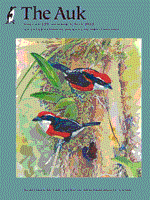Males of monogamous species are expected to increase their overall fitness by engaging in extrapair copulations, but the fitness implications of this behavior for females are somewhat less clear. Numerous studies have examined the potential benefits of extrapair mating to females, but the costs of extrapair mating, which may be substantial, are less well studied. Quantifying these costs is critical to understanding the evolution of extrapair mating behavior in females. We examined the costs of extrapair paternity to female Red-backed Fairy-wrens (Malurus melanocephalus) using an 8-year data set that allowed us to examine both short-term and long-term costs. The variability of individual extrapair mating behavior in female Red-backed Fairy-wrens allowed us to compare the parental care, fecundity, and apparent survival of faithful and promiscuous females. We found no effect of the presence of extrapair offspring on the rate at which males provisioned broods. We also found that promiscuous and faithful females did not differ with respect to apparent annual survival and four indices of reproductive success. These findings suggest that there are few or no costs to extrapair mating in females in this population. Low costs, as documented here, may contribute to the evolution of high extrapair paternity rates observed in many species; thus, our results underscore the importance of both costs and benefits in explaining the evolution of extrapair mating behavior in females.
How to translate text using browser tools
1 July 2012
Female Red-Backed Fairy-Wrens (Malurus Melanocephalus) Do Not Appear to Pay a Cost For High Rates of Promiscuity
Claire W. Varian-Ramos,
Willow R. Lindsay,
Jordan Karubian,
Michael S. Webster
ACCESS THE FULL ARTICLE

The Auk
Vol. 129 • No. 3
July 2012
Vol. 129 • No. 3
July 2012
direct costs
extrapair paternity
Malurus melanocephalus
paternal care
reproductive success
survival




